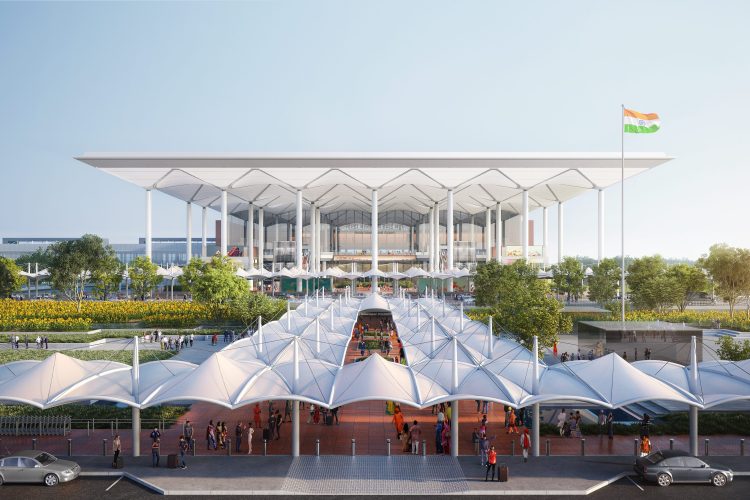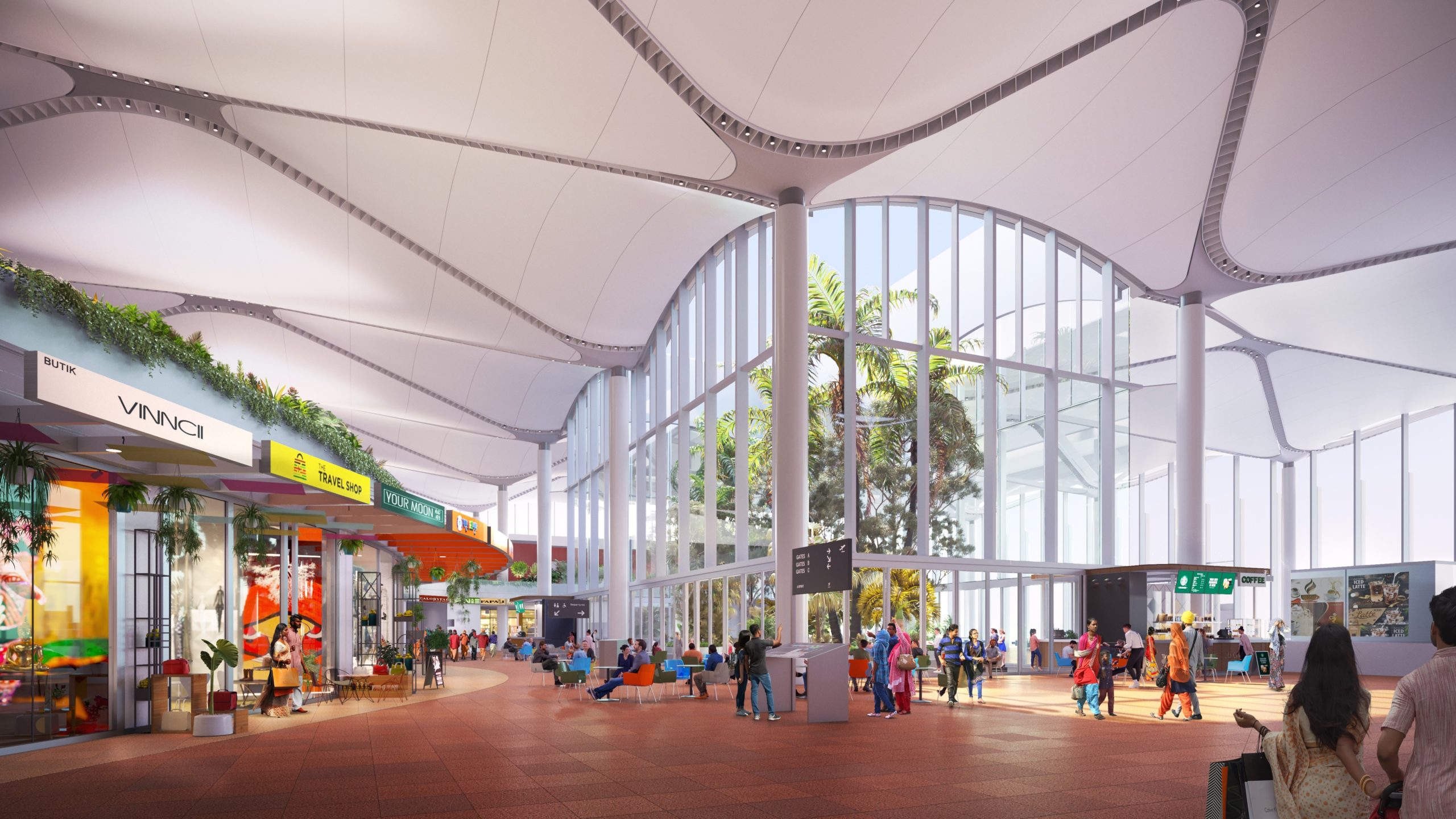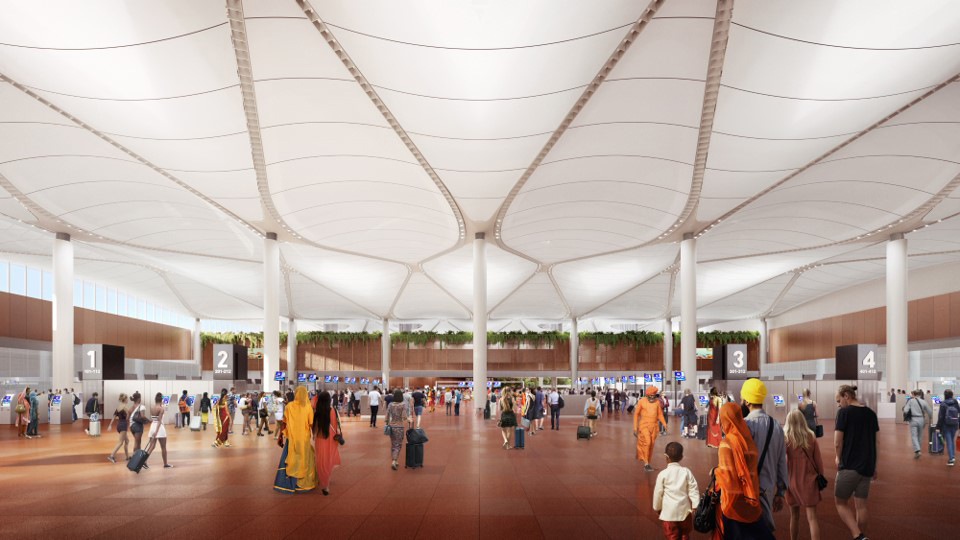Noida International Airport: A unique new gateway between India and the world
- Like
- Digg
- Del
- Tumblr
- VKontakte
- Buffer
- Love This
- Odnoklassniki
- Meneame
- Blogger
- Amazon
- Yahoo Mail
- Gmail
- AOL
- Newsvine
- HackerNews
- Evernote
- MySpace
- Mail.ru
- Viadeo
- Line
- Comments
- Yummly
- SMS
- Viber
- Telegram
- Subscribe
- Skype
- Facebook Messenger
- Kakao
- LiveJournal
- Yammer
- Edgar
- Fintel
- Mix
- Instapaper
- Copy Link
Posted: 11 April 2023 | | No comments yet
For International Airport Review Issue 1 2023 Nicolas Schenk, the Chief Development Officer at Noida International Airport, describes the exciting airport development project which will be leading the way in terms of passenger experience and sustainability.


Credit: Noida International Airport
Noida International Airport (NIA) is being developed as a greenfield airport that will connect the greater Delhi area and Western Uttar Pradesh with other cities in India and the world. This world-class airport will combine Swiss efficiency and Indian hospitality to offer rich experiences and comprehensive commercial attractions and services to its passengers. NIA will be the first airport in its class in India to achieve net zero emissions, setting a new standard for holistic sustainable airport operations.
At its projected opening at the end of 2024, the airport will feature one runway and one terminal and handle a capacity of 12 million passengers – with potential for further development in additional construction phases. The proposed Master Plan for NIA includes four phases with an ultimate capacity of 70 million annual passengers (MAP) spread across two runways and two terminals.
Yamuna International Airport Private Limited (YIAPL) was established for the development, construction and operation of the greenfield project – Noida International Airport. The company, a 100% subsidiary of Zurich Airport International AG, will be responsible for the implementation of the public‑private partnership project in close partnership with the Government of Uttar Pradesh and the Government of India. The concession period for Noida International Airport commenced on 1 October 2021 and will run for 40 years.
Design approach: Indian hospitality and Swiss efficiency
The airport design is an amalgamation of experiences and processes. While the user experiences will be Indian, the world-class processes – influenced by Zurich Airports’ international experience – will demonstrate Swiss efficiency.
The terminal architecture will embrace local cultural and social aspects. The three distinctive features of the design expressing this aspect are The Forecourt, The Courtyard and The Landscape.


The Courtyard. Credit: Noida International Airport
The Forecourt
All passengers and well-wishers are greeted at terminal entry with a huge forecourt. This semi‑open space creates a natural hierarchical movement of passengers from the drop-off zone to the terminal’s entry. The forecourt is designed to mitigate the harshness of the climate and help users enjoy the time before starting their journey or simply encourage them to spend time at the airport and enjoy the atmosphere.
The Courtyard
Inspired by the vernacular architecture and climate‑responsive style, we have planned a courtyard right in the middle of our departure lounge. This allows us to bring daylight and ambient air deep into the terminal and allow some sunny spots during winter afternoons. This helps us improve passenger wellbeing and stay sustainable with reduced energy costs.
The Landscape
Consciously reflecting the state of Uttar Pradesh, as a major region the airport is serving, the approach to the airport will be landscape in its real form. It will reflect the characteristics of the agricultural capital of India with native species and the look of natural fields.
These distinctive features of the terminal, along with warm hues and intricate work in interiors like latticework inspired from the Purvanchal region and the wavy roof signifying the key rivers of the state, will provide the unique feel of Indian hospitality and warmth.
On the other hand, the various functional processes within the terminal are all driven by the Swiss style of simplifying processes and delivering efficiency. The terminal will introduce unique operational facilities for providing a seamless travel experience to its users. These will be the Ground Transport Centre and the swing stands.
The Ground Transportation Centre (GTC) is designed as a multi-modal hub which integrates a rail network of metro and high-speed rail along with bus, car and taxi services. Passengers will be able to transit within either mode of travel seamlessly at Noida International Airport.
Similarly, for easy and quick turnarounds of aircraft on the apron stands, we will introduce swing stands for the first time in India. These stands will allow aircraft to arrive as international and depart as domestic or vice versa. This will bring in operational efficiencies for airlines, while simplifying the passenger flows. The terminal design perfectly blends human wellbeing, technology, and aesthetics.
Holistic approach to sustainability: Net zero emissions
Zurich Airport has set the vision for Noida International Airport to become India’s first net zero emission airport operator. Sustainability is a key focus area for Zurich Airports and this approach flows down to all other companies and projects in progress. Four sub-concepts have been developed in the areas of energy, fuels, waste, and water to identify feasible solutions. Accordingly, Noida International Airport has decided on the sub-concepts for Phase 1 (up to 12 MAP) to pursue in the design, construction, and operation of the airport.


Check-in Hall. Credit: Noida International.
NIA has finalised three sub concepts for net zero:
- Net zero energy
- Net zero waste
- Net zero water
The airport development team is working across these four areas to execute projects such as zero liquid discharge STP, onsite solar farm, waste management facility, use of green fuel, rainwater harvesting projects amongst others as per the net zero requirements.
NIA has recently defined an environment policy for their operations, to enhance efforts towards environment conservation and protection. This policy will be communicated to all the stakeholders working on site to align them with the vision.
Special precautions are being taken during airport construction activity to reduce the impact on the environment. A construction, environmental and social management plan has been prepared with 22 sub-plans to care for, and protect, the overall ecosystem of the construction site. Important issues like dust management, noise management, waste management and disposal are given more emphasis on site. All environmental quality parameters are being monitored regularly to ensure that the site environment is not polluted.
Green building certification requirements have been incorporated in the design. Requirements of net zero certification and health and wellbeing certification are also considered in the design of terminal building. The overall focus is on implementation of Green Campus Certification requirements to cover the entire site. There are plans to implement Environment Management System – ISO 14001 and Energy Management System – ISO 50001 during the operational phase of the airport. As a global requirement, NIA will also adhere to global reporting initiatives (GRI) for sustainability reporting.
Digital airport: Facilitating contactless travel in a post-pandemic world
NIA will connect people and places, creating positive experiences. Based on this purpose, we take a very strategic approach to digitalisation. We want to set new airport benchmarks in experience, efficiency and earnings by focusing on the following three pillars:
- Great customer experience by offering a seamless and predictable journey from home to the gate and vice-versa
- Best-in-class turnaround and connecting processes which are both beneficial for airlines and passengers
- Offering new, exciting and customised products and services which not only differentiate NIA but create a destination attractive for our guests.
Based on these three pillars we will create best-in-class processes derived from our key value streams (guest, airlines and cargo) which help us guide our digitalisation efforts and provide the biggest impact.
Our digital strategy envisions utilising a state-of-the-art website to turn our guest’s smartphones into the prime device during their journey at NIA. Everything will be available, at one stop, on NIA mobile app, from flight information to pre-ordering food to indoor navigation. We will support the passengers at every step of their journey making it seamless and hassle-free.
We believe in data-driven decision-making throughout our airport ecosystem. Hence, a key pillar of our digital strategy is setting up a holistic data platform. This will provide all NIA stakeholders with common situational awareness, which serves as the basis for rapid joint decision making among the operational staff of the airport ecosystem.
Finally, utilising the potential of digitalisation requires the right people with the right mindset, who can strive in an enterprising culture and agile environment. Supporting them with the right resources and organisational structure will enable us to achieve our vision for digitisation.
Efficiency-focused operational philosophy
Our operational philosophy goes hand-in-hand with the digital strategy for the airport, clearly focused on efficiency. Owing to our vision of being a process driven organisation, Noida International Airport will set a landmark in process efficiency and operational excellence, benefiting all customers and consumers. From kerb to gate, our procedures are designed to enable seamless flow and great passenger experience.
We strongly believe in common use infrastructure to keep waiting times at a minimum and maximise availability of the facilities. While in the past passengers were bound to counter opening times, at NIA they will be able to drop their bag in self-bag‑drop zones at any time to their convenience, allowing airlines to reduce their staff costs. Even better, with direct metro connectivity to the airport, passengers will be able to leave their bags on arrival at the airport, by dropping them directly at the foreseen self‑bag-drop zone inside the metro station.
By implementing body scanners, automated tray return systems, remote screening and passenger flow management, we will provide a much enhanced security experience at Noida International Airport. These measures will also keep waiting times and stress level at a minimum.
At Noida International Airport, our vision is to provide an efficient and user-friendly airport for passengers as well as airlines and other airport partners. Our efficient processes will result in lower operating costs for the airlines operating from NIA. While we foresee a majority of flights being purely domestic, all international contact gates are designed to accommodate mixed rotations. This means that an aircraft can arrive domestic and depart international or vice versa, without any requirement of towing the plane. All remote stands will be equipped with underground fuel pits as well as installations to provide ground power to the aircraft. Keeping our sustainability targets in mind, diesel vehicles will be avoided wherever possible, consequently there will also be outlets to power electric pre-conditioned air units on remote stands.
It will be critical to ensure punctuality of the traffic and optimisation of overall operations. To this end, the airport operations centre will implement a collaborative operations plan, focusing on airside operations as well as total airport management. We will work towards anticipating delays and disruptions in advance using predictive algorithms, to initiate requisite mitigation measures well in time. All stakeholders will actively participate in the APOC and contribute to a common decision basis by sharing of data and information.
A leading airport
Noida International Airport (NIA) will be India’s leading airport in terms of customer service, efficiency, digital services, logistics ecosystem with minimal environmental impact. We will provide quick, efficient processes at the best value to passengers, airlines and logistics partners. The airport will deepen air connectivity from Noida – the biggest contributor to Uttar Pradesh’s economy in the last decade and the fastest growing business and commercial hub in India. The government’s strong focus to drive infrastructural development will augment multimodal connectivity to the airport.
Given the strides taken by the sector towards recovery which started in the summer season 2022, we are confident that traffic will increase exponentially from here-on, reiterating the need for developing adual-airport system in the National Capital Region. Our global lineage (Zurich Airport International) and expertise will be crucial in developing and managing one of the first Dual-Airport City Systems in India.
About the author


Presently he is responsible for infrastructure development of the new greenfield Noida International Airport in India at Jewar, Uttar Pradesh.
Issue
Related topics
Airport construction and design, Airport development, Passenger experience and seamless travel, Passenger volumes, Sustainability
Related airports
Related organisations
Yamuna International Airport Private Limited (YIAPL), Zurich Airport International AG (ZAI)


















